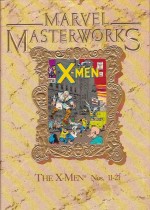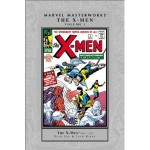

By Stan Lee, Jack Kirby, Roy Thomas, Werner Roth, Dick Ayers & various (Marvel)
ISBN: 0-87135-482-9
In 1963 things really took off for the budding Marvel Comics as Stan Lee & Jack Kirby expanded their diminutive line of action titles, putting a bunch of relatively new super-heroes together as the Avengers, launching a decidedly different war comic in Sgt Fury and his Howling Commandos and creating a group of alienated but valiant teenagers who were called together to fight a rather specific threat to humanity.
After spectacular starts on all those titles, Kirby’s increasing workload compelled him to cut back to simply laying out these lesser lights as Thor and Fantastic Four evolved into perfect playgrounds and full-time monthly preoccupations for his burgeoning imagination. The last series he surrendered was the still-bimonthly X-Men wherein outcast tribe of mutants Cyclops, Iceman, Angel, Beast and Marvel Girl – very special students of wheelchair-bound telepath Professor Charles Xavier -worked diligently and clandestinely to foster peace and integration between the unwary masses of humanity and the gradually emergent race Homo Superior.
This second lavish deluxe edition covers issues #11-21 (May 1965 to June 1966) and features two key transitional moments as first Kirby and then Stan Lee handed the series over to fresh new talent…
A major turning point signalled The King’s departure in #11 with ‘The Triumph of Magneto!’ as our heroes and the Brotherhood of Evil Mutants both searched for a fantastically powered being called The Stranger. None were aware of his true identity, nature or purpose, but when the Master of Magnetism found him first it spelt the end of the war with the X-Men…
With Magneto gone and the Brotherhood broken, Kirby relinquished the pencilling to other hands, providing loose layouts and design only. Alex Toth & Vince Colletta proved an uncomfortable mix for #12′s tense drama ‘The Origin of Professor X!’ – the start of a two-part saga which introduced Xavier’s half brother Cain Marko and revealed that simple lout’s mystic transformation into an unstoppable human engine of destruction.
The story concluded with ‘Where Walks the Juggernaut’, a compelling tension-drenched tale guest-starring the Human Torch, but most notable for the introduction of penciller Werner Roth (using the name Jay Gavin) who would be associated with the mutants for the next half decade. His inker for this first outing was the infallible Joe Sinnott.
Roth was an unsung veteran of the industry, working for the company in the 1950s on such star features as Apache Kid and the inexplicably durable Kid Colt, Outlaw, as well as Mandrake the Magician for King Features Comics and Man from U.N.C.L.E. for Gold Key. As with many pseudonymous creators it was his DC commitments (mostly romance stories) which forced him to disguise his moonlighting until Marvel grew big enough to offer him full-time work.
‘Among us Stalk the Sentinels!’ from issue #14 (inked by Colletta), celebrated the team’s inevitable elevation to monthly publication with the first chapter of a three-chapter epic introducing anthropologist Bolivar Trask, whose solution to the threat of Mutant Domination was super-robots that would protect humanity at all costs. Sadly their definition of “protect†varied wildly from the expected, but what can you expect when a social scientist dabbles in high-energy physics and engineering?
The X-Men took the battle to the Sentinels secret base and became ‘Prisoners of the Mysterious Master Mold!’ before wrapping up their ferrous foes with ‘The Supreme Sacrifice!’ Veteran Dick Ayers joined as inker from #15, his clean line blending perfectly with Roth’s clean, classicist pencils. They remained a team for years, adding vital continuity to this quirky but never top-selling series.
X-Men #17 dealt with the aftermath of the battle – probably the last time the US Army and government openly approved of the team’s efforts – and the sedate but brooding nature of ‘…And None Shall Survive!’ enabled the story to generate a genuine air of apprehension as the Xavier Mansion was taken over by an old foe who picked them off one by one until only the youngest was left to battle alone in the climactic conclusion ‘If Iceman Should Fail..!’
‘Lo! Now Shall Appear… The Mimic!’ in #19 was Lee’s last script, a pithy tale of a troubled teen with the ability to copy the skills, powers and abilities of anyone in close proximity, after which the writing reins were turned over to Roy Thomas in #20, who promptly jumped in guns blazing with ‘I, Lucifer…’ an alien invasion yarn that starred Xavier’s arch-nemesis as well as Unus the Untouchable and the Blob, revealing in passing how Professor X lost the use of his legs.
With the canny concluding part ‘From Whence Comes Dominus?’, Thomas & Roth completely made the series their own, blending juvenile high spirits, classy superhero action and torrid soap opera with beautiful drawing and stirring adventure.
At this time Marvel Comics had a vast and growing following among older teens and college kids, and the youthful Thomas spoke and wrote as they did. Coupled with his easy delight in large casts this would increasingly make X-Men a very welcoming read for we adolescents…
These quirky tales are a million miles removed from the angst-ridden, breast-beating, cripplingly convoluted X-brand of today’s Marvel and, in many ways are all the better for it. Well drawn, highly readable adventures are never unwelcome or out of favour, and it should be remembered that everything here informs so very much of the mutant monolith. These are stories for the dedicated fan and newest convert, and never better packaged than in this fabulously stylish full-colour tome. Everyone should have this book.
© 1965, 1966, 1988 Marvel Characters, Inc. All Rights Reserved.
